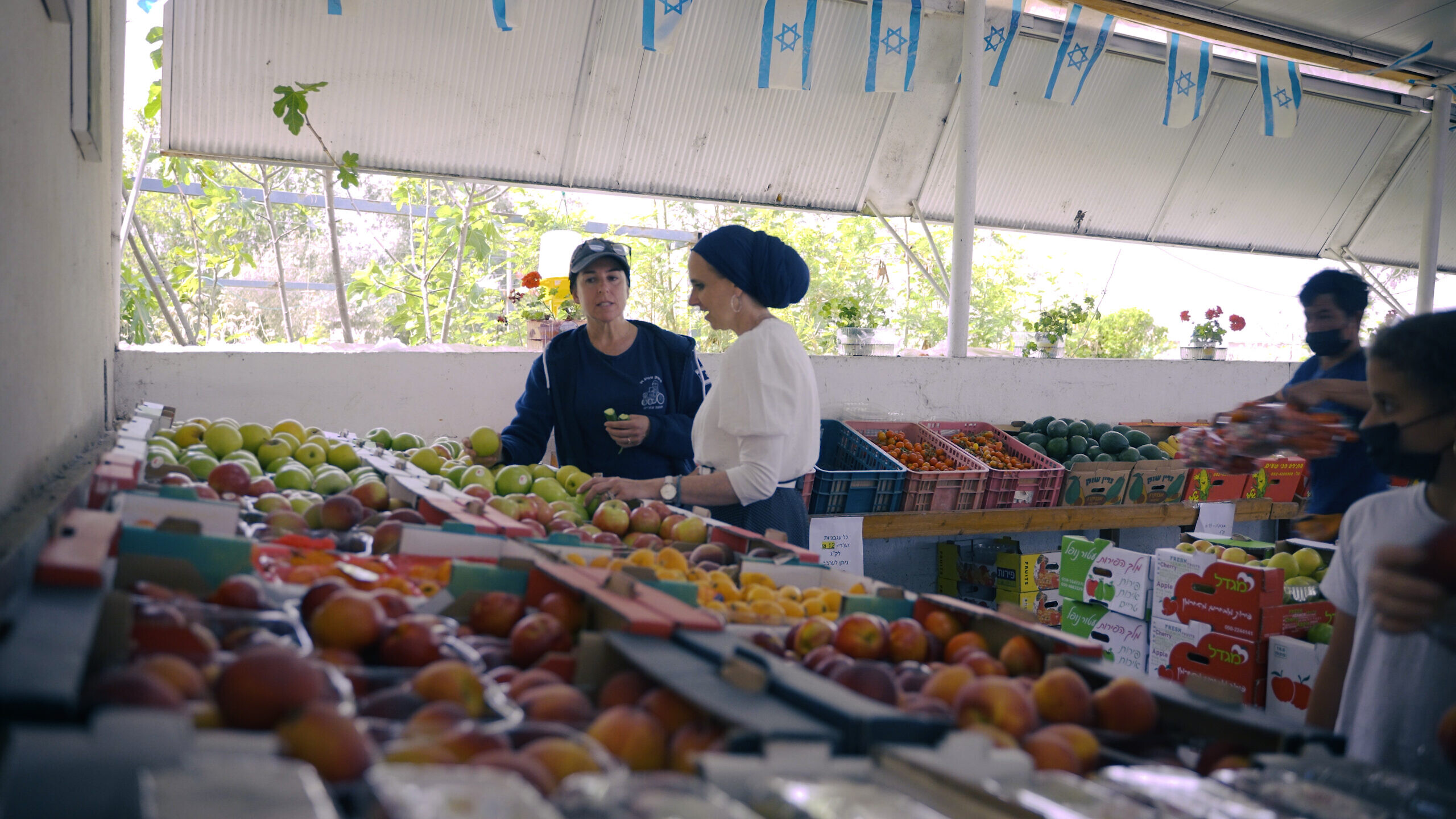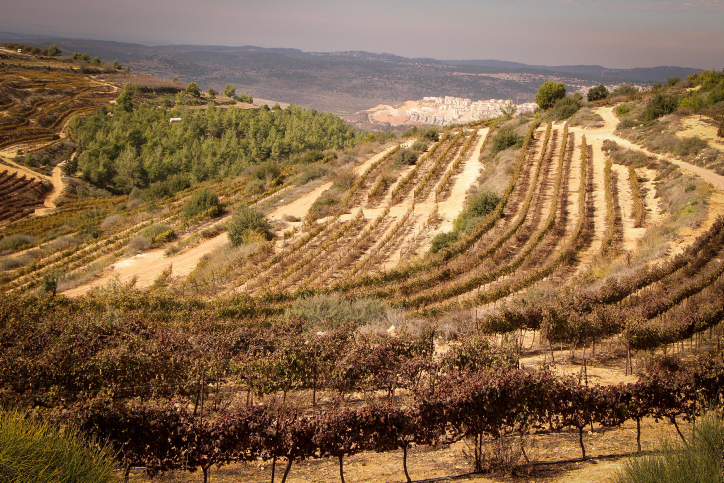
How does resting the land work in modern-day Israel where, even during the other six years, many farm families live hand to mouth?
“Grant blessing on the face of the Earth and from its goodness satisfy us, blessing our year as the best of years. Blessed are you G-d who blesses the years.” — Morning prayers
If you look up the word emunah in a dictionary, you just might find Doron and Ilana Toweg’s pictures there.
Because if these farmers and their four kids living near Beit Shemesh didn’t have emunah—that’s Hebrew for “faith”—they would never have had the courage to take on the mitzvah of shmita.
That’s because shmita—the Torah commandment to let the land rest every seven years—means: no planting or harvesting can be done, effectively putting the farmer out of business for more than a year.
American-born and Canadian-raised, Ilana moved to Israel when she was 18, only taking on the agricultural life after her marriage 25 years ago to her third-generation farmer husband.
“We understood the basics then, but we really didn’t know what we were getting into,” says Ilana with a good-natured sigh. Still, she was determined that her family “would take on a mitzvah that only Israel’s few thousand farmers have the opportunity to keep. I began seeing it as a special blessing to be in the position to do this.”

But back then, her husband was not so easily persuaded. “Doron works from before dawn to late at night—the farm is his life—and the idea of not working for a year and having no income was frightening,” she says.
So what convinced him? Visiting a neighboring farm, he met some yeshivah students picking grapes. “One of them said that for 2,000 years, the Jews were in the galut (‘exile’) waiting to keep this mitzvah,” says Ilana. “And now, we have the opportunity to actually do it.”
But, as they were soon to discover, in addition to abundant emunah, shmita means hard work. Ilana taught kindergarten in the morning and English in the afternoon, and Doron led farm tours, while their kids—then 17, 13, 10 and 3—pitched in at home.
‘Judaism teaches us to respect the earth’
In the Torah portion of Behar, G-d instructs Moses on Mount Sinai to tell the Children of Israel that “for six years you may sow your field and for six years you may prune your vineyard and you may gather in its crop. But the seventh year shall be a complete rest for the land, a Sabbath for Hashem; your field you shall not sow and your vineyard you shall not prune. The aftergrowth of your harvest you shall not reap and the grapes you have set aside for yourself you shall not pick. It shall be a year of rest for the land.”
Besides those like the Towegs who take on the Torah’s commandment of shmita, other farmers choose to “sell” their land to a non-Jew but keep working it.
Though considered acceptable by many, this option contravenes the spirit of the mitzvah that calls for a complete “Sabbath” for the land, notes Hershkowitz. And whatever produce grows naturally? It’s considered hefker—communal property—for anyone to help themselves, but not to be sold.
“The farmers and their families who keep shmita are the real heroes here,” says Rabbi Ezra Friedman, director of the Gustave & Carol Jacobs Center for Kashrut Education at the Orthodox Union in Jerusalem.
“Imagine you have to close your business for a year and watching your old customers walk by to shop somewhere else, wondering if they’ll be back at the end of the year. This takes a lot of courage and faith.”
But how does shmita work in modern-day Israel where, even during the other six years, many farm families live hand to mouth?
The roughly 25 percent of Jewish-owned Israeli farmland that kept shmita seven years ago received a helping hand from an 80-year-old organization named Keren Hashviis (the Foundation for the Sabbath Year).
During the last shmita, Keren Hashviis helped keep 3,452 farmers covering 83,500 acres going, says project manager Dovid Hershkowitz. And this year, with some 40 percent of the land already on board for shmita, Keren Hashviis is working hard to raise money to keep up with the new demand and encourage others to join in the mitzvah, more than doubling its old $25 million budget.
These grants cover 40 percent to 50 percent of a farm’s operating expenses—everything from rent on the land to installment payments on tractors, combines and other pricey equipment and salaries for the skeleton crew who care for the animals and keep the fruit trees hydrated and alive.
This year’s Keren Hashviis goal is an ambitious one: that the majority (51 percent) of Jewish farmland keeps shmita.
Surprisingly, even after more than a year of pandemic lockdowns, including many restaurants and hotels that usually buy farmers’ produce in quantity, and even looking at a 13-month year coming up (added for the Jewish leap year beginning on Rosh Hashanah), Hershkowitz calls the increase in farms primed to keep shmita for the first time “dramatic.”

These farmers and all those who would jump on the shmita bandwagon if they thought they could afford it keep Keren Hashviis’s American CEO Rabbi Shia Markowitz on the road raising money. So does the memory of a refrigerator he saw seven years ago.
“I was visiting a farm family and happened to see ‘past due’ notices for electricity and phone service stuck on their refrigerator,” he says. “That image is always there to motivate me, knowing that we have it in our hands for more farmers to keep the mitzvah without facing financial ruin.”
“People think it’s a vacation for farmers, but it’s anything but,” he adds. “They have to keep their fruit trees alive, their equipment payments on time, and their families and their animals fed.”
“I’m a little amazed at how many more farmers have already signed on than seven years ago,” says Ehud Alpert, livestock manager and shmita coordinator for the Ministry of Agriculture and Rural Development.
The ministry administers a program of stipends of up to 12 percent of their average year’s income to those farmers who contribute an additional 6 percent from their own earnings. And whereas only 150 benefited from the program during the last shmita, more than 300 have applied and been approved this time around.
“The support is to help them come back strong the next year, so they can go back to the land and continue to produce the excellent fruits and vegetables Israel is known for,” says Alpert, adding his hope that the increased demand will prompt the Treasury Department to approve the request for “an additional budget to help more farmers out.”
One reason they could come back even stronger is the simple act of letting the land take a break from constant productivity. “Judaism teaches us to respect the earth, so with shmita, every seven years we need to give it a rest to recharge and refuel,” says Aharon Ariel Lavi, who directs Hakhel, an intentional community incubator and project of Hazon that, among other things works for environmental sustainability.
“Even with fertilizers and other methods designed to bypass that need, we still need to respect nature not just for what it can do for us, but what we are responsible to do for it.”
Of course, this is just one of a few rational explanations. The most important reason for Shmita, by far, is Hashem’s command. [Ed].
‘Jewish unity at its best’
But as helpful as it is to have these infrastructure costs at least partially covered, how will the families pay for the increasing cost of food? Shoes for growing kids? Textbooks and backpacks for school? Or that unexpected root canal? How, in fact, will they survive?
That’s where the world’s Jewish women come in.
As the mother of eight, Nahva Follman is no stranger to surprise expenses.
“We also know that it’s the entire family that lives with shmita,” says the native of Brooklyn, N.Y., who now lives in Jerusalem. “And the only way they can do it is if we step up and help.”
So, just as Keren Hashviis takes on much of the big infrastructure expenses, its newly born Nshei Keren Hashviis program aims at helping the keeping the family with the unexpected costs of living for the next year-plus, until the fields begin producing again.

Working through online giving and through funds being run in various communities, the project is collecting a dollar a day ($365) from women across the globe and aiming for 100,000 of them. “That would help feed thousands of farm families, buy the kids shoes and lunch boxes, and new clothes for school,” says Follman. “We want to put money on their kitchen table and say, ‘We’ve got your back. Since you’re courageous enough to take on this immense mitzvah, you shouldn’t have to lie awake at night wondering how you’re going to pay for everything till the farm starts producing again.’ ”
That safety net is bound to bring a measure of relief, says farmer Ilana Toweg. “And it comes from other Jewish women many of whom have raised families and dealt with the surprise costs you never budget for nor can necessarily afford.”
As N’shei committee chair who’s volunteered to help the farm families afford this mitzvah, at 45, Follman also puts her whole self where her heart is. Three years ago, when her youngest was 4, she donated a kidney to a surgeon who’d made aliyah from Ukraine. “So now, every time he operates on someone,” she says with a grin, “I get part of that mitzvah, too.”
Follman also considers it a mitzvah to empower Jewish farmers to take on shmita. “With so many sitting on the fence, as Rosh Hashanah gets closer they have to decide if they’re going to do it. We want to be there to help that happen, woman to woman.”
“There’s a reason G-d gave us such a seemingly impossible mitzvah to perform,” says Rabbi Markowitz. “He knew the only way the farmers can succeed at it and survive is if the rest of the Jewish people make the mitzvah work if we do it together. This is Jewish unity at its best.”
Rochel Miller, who’s organized a Nshei fund with the women in her Brooklyn community, is also determined to help enable this mitzvah. “But even with our help and the support from Keren Hashviis, the farmer families will get maybe half of what they earn in a normal year,” she says. “The rest they’ll still have to scramble for.”
Over at the Towegs’ farm, such scrambling will include Ilana taking on more English students, and Doron and the family leading (bilingual) guided farm tours to demonstrate how shmita works.

Seven years ago, Ilana also took another job— one that she never applied for and that pays in strictly non-monetary terms. It all began when two young women knocked on the door saying haredi leader Rabbi Chaim Kanievsky had sent them for a blessing to find husbands since “God listens to the prayers of any woman with enough emunah for her husband to keep shmita.”
These days, Ilana, who’s not haredi herself, spends hours over her Shabbat candles reciting the names of the thousands of individuals, asking for blessings for everything from healing to financial help to having children to finding their soulmate. And those two young women who’d knocked on her door? Within two months, they were both engaged.
“We feel so supported by the Jewish people that this is something I can do to help them,” she says.
“As scary as it is to turn off your income and lose your contracts for more than a year, shmita is feeling right to us now. This year, instead of growing eggplants for thousands of people, we figure we’re keeping this mitzvah for those same thousands. And everyone who’s helping us, they’re all our partners.”
(JNS).